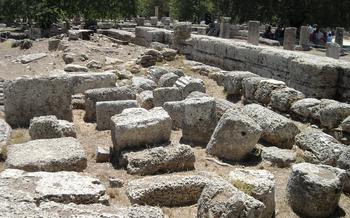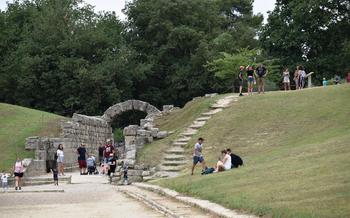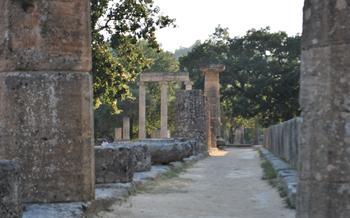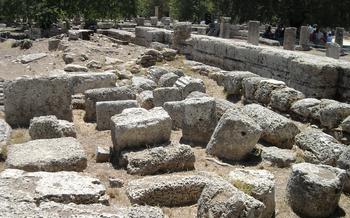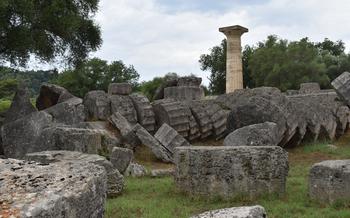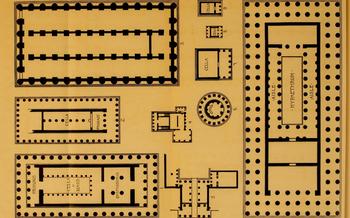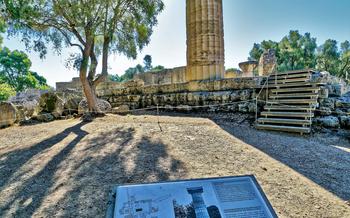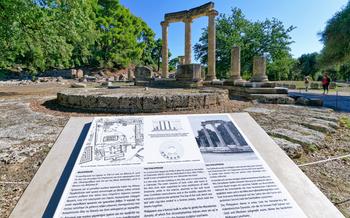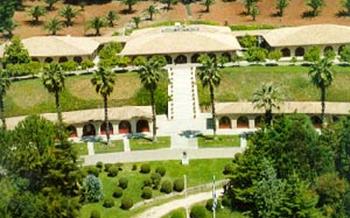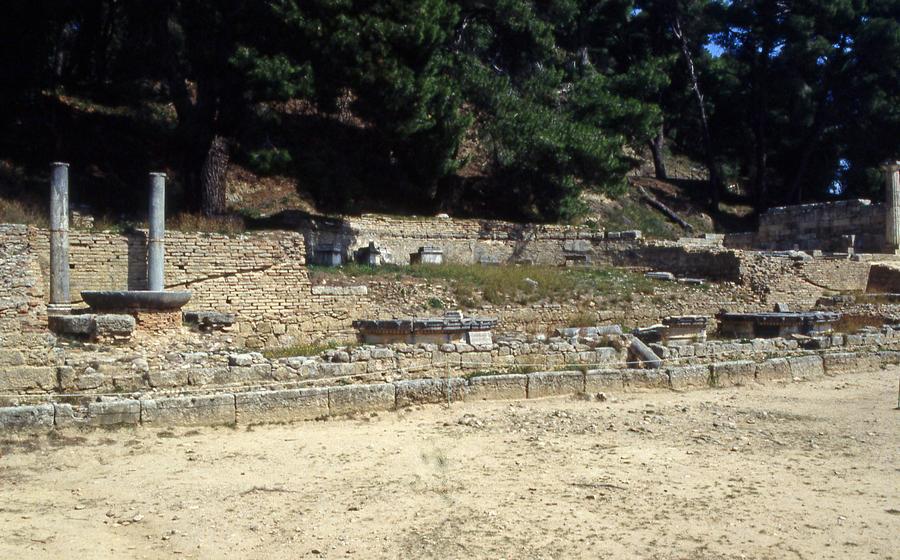
Nymphaeum of Herodes Atticus
- Olympia: A Journey to the Realm of Ancient Gods and Athletes
- Nymphaeum of Herodes Atticus: An Oasis of Tranquility and Elegance
- A Glimpse into the Life of Herodes Atticus, the Nymphaeum's Patron
- The Nymphaeum in Context: Olympia's Other Architectural Wonders
- Unveiling the Ancient Olympic Games at the Museum of Olympia
- Following in the Footsteps of Ancient Athletes at the Olympic Stadium
- Discovering the Treasuries: Sanctuaries of Ancient City-States
- Exploring the Enchanting Altis: The Sacred Precinct of Olympia
- Indulging in Local Delights: Traditional Greek Cuisine in Olympia
- Unveiling the Secrets of the Archaeological Museum of Olympia
- Strolling through the Picturesque Village of Olympia
- Venturing Beyond Olympia: Exploring the Peloponnese Region
- Insider Tip: Unveiling the Hidden Gems of Olympia
Olympia: A Journey to the Realm of Ancient Gods and Athletes
Olympia, nestled in the picturesque valley of Elis in the Peloponnese region of Greece, is a place of immense historical significance. It served as the birthplace of the Olympic Games in ancient Greece, a momentous event that celebrated athleticism, sportsmanship, and the worship of the Greek gods. Olympia was considered a sanctuary dedicated to the Olympian deities, particularly Zeus, the king of the gods. The site's religious significance attracted pilgrims and athletes from all corners of the ancient world, who came to pay homage to the gods and compete in the Olympic Games.
Visiting Olympia today is like stepping back in time to witness the grandeur of ancient Greece. The best time to visit is during spring (March-May) or autumn (September-October) when the weather is pleasant, and the crowds are smaller. Olympia is easily accessible by car, bus, or train from Athens or other major cities in Greece, making it a convenient destination for history buffs, sports enthusiasts, and travelers seeking a glimpse into the birthplace of the Olympic tradition.
Nymphaeum of Herodes Atticus: An Oasis of Tranquility and Elegance
Within the hallowed grounds of Olympia, nestled amidst the ruins of ancient temples and sporting arenas, lies a hidden gem that whispers tales of opulence and artistry—the Nymphaeum of Herodes Atticus. This monumental fountain house, built by the wealthy Roman senator Herodes Atticus in the 2nd century AD, stands as a testament to the grandeur and patronage of the Roman elite in Greece.
Its imposing facade, adorned with intricately carved Corinthian columns and exquisite sculptures, beckons visitors to step into an oasis of tranquility and elegance. Inside, a large rectangular basin, surrounded by marble benches and niches once adorned with statues, invites visitors to linger and soak in the serene atmosphere.
The Nymphaeum's intricate water system, fed by a nearby spring, once cascaded into the basin, creating a soothing symphony of sounds that echoed through the chamber. This elaborate fountain served as a place for relaxation, social gatherings, and religious ceremonies, where the wealthy and influential sought respite from the bustling city.
The artistic significance of the Nymphaeum extends beyond its architectural beauty. Its decorative elements, including statues, reliefs, and mosaics, showcase the exceptional craftsmanship of ancient Greek and Roman artisans. Each piece tells a story, depicting mythological scenes, historical events, and the divine figures who presided over Olympia.
The Nymphaeum of Herodes Atticus stands as a testament to the intersection of art, wealth, and power in ancient Greece. Its grandeur reflects the influence of the Roman Empire and the enduring legacy of Herodes Atticus, a man who sought to beautify and enrich the sacred site of Olympia, leaving behind a masterpiece that continues to inspire awe and wonder to this day.
A Glimpse into the Life of Herodes Atticus, the Nymphaeum's Patron
Herodes Atticus, the wealthy Roman senator who commissioned the construction of the Nymphaeum, was a prominent figure in the Roman Empire during the 2nd century AD. Born into a wealthy Athenian family, he received a privileged education and became a renowned orator, philosopher, and patron of the arts. Herodes Atticus held various important positions in the Roman administration, including consul of Asia and governor of Greece. He was known for his generosity and philanthropy, supporting various construction projects and sponsoring cultural events throughout the Roman world.
His motivations for building the Nymphaeum were manifold. Firstly, he wanted to honor his wife, Aspasia Annia Regilla, who had passed away prematurely. The Nymphaeum was intended as a tribute to her memory and a symbol of their love. Secondly, Herodes Atticus sought to contribute to the beautification of Olympia, a sanctuary that held great religious and cultural significance for the Greeks. By constructing such an elaborate and impressive fountain house, he aimed to enhance the overall grandeur and splendor of the site.
Herodes Atticus's patronage of the Nymphaeum reflects his deep appreciation for the arts and his desire to leave a lasting legacy. He spared no expense in commissioning the finest architects, sculptors, and artisans to create a masterpiece that would stand the test of time. The Nymphaeum's intricate design, exquisite decorations, and harmonious proportions showcase Herodes Atticus's refined taste and his commitment to artistic excellence.
His legacy as a renowned philanthropist and patron of the arts extends beyond the Nymphaeum. Herodes Atticus also funded the construction of the Odeon of Herodes Atticus in Athens, a magnificent theater that is still used for performances today. His generosity and contributions to the cultural landscape of the Roman Empire earned him widespread admiration and respect. Herodes Atticus's name remains synonymous with patronage, munificence, and a deep appreciation for the arts and culture.
The Nymphaeum in Context: Olympia's Other Architectural Wonders
Beyond the Nymphaeum, Olympia is a treasure trove of ancient wonders. The Temple of Zeus, one of the Seven Wonders of the Ancient World, commands attention with its imposing size and grandeur. Inside, the colossal statue of Zeus by Phidias, crafted from ivory and gold, once stood as a testament to the god's majesty.
The Temple of Hera, dedicated to Zeus's wife, is another architectural marvel. Its well-preserved sculptures depict the legendary Labors of Hercules, showcasing the intricate craftsmanship of ancient Greek artisans.
The Pelopion, a sanctuary honoring the mythical hero Pelops, features an impressive tholos tomb. This circular structure, with its conical roof supported by columns, is a unique architectural gem that adds to Olympia's rich tapestry of ancient ruins.
Unveiling the Ancient Olympic Games at the Museum of Olympia
The Museum of Olympia stands as a testament to the grandeur and significance of the ancient Olympic Games. Within its walls, a treasure trove of artifacts awaits visitors, offering a glimpse into the history, rituals, and cultural impact of this monumental event.
Among the museum's highlights are exquisite statues of athletes, capturing the essence of their strength, agility, and determination. Bronze statuettes depict various sporting events, showcasing the diverse competitions that took place during the games. Pottery adorned with intricate designs portrays athletes in action, immortalizing their achievements and the spirit of competition.
Interactive displays and multimedia presentations bring the ancient games to life, allowing visitors to experience the excitement and drama that unfolded in Olympia centuries ago. Through these immersive exhibits, visitors can learn about the training methods, rituals, and traditions associated with the games, gaining a deeper understanding of their cultural and historical significance.
The Museum of Olympia is a must-visit for anyone interested in exploring the roots of the modern Olympic Games and delving into the rich history of this ancient sporting event. It serves as a reminder of the enduring legacy of Olympia, where the spirit of competition and the pursuit of excellence continue to inspire athletes and sports enthusiasts worldwide.
Following in the Footsteps of Ancient Athletes at the Olympic Stadium
In the heart of ancient Olympia, where history and legend intertwine, lies the Olympic Stadium, an awe-inspiring testament to the birthplace of the Olympic tradition. Step into this sacred arena, where the echoes of ancient athletes' footsteps still linger, and imagine the thrill and determination they must have felt as they competed for glory and honor.
The stadium, with its elongated, U-shaped layout, is remarkably well-preserved, allowing visitors to vividly envision the ancient games. The starting line, marked by parallel grooves in the stone, beckons you to stand where legendary athletes once poised themselves, their hearts pounding with anticipation. At the far end, the finish line awaits, a symbol of triumph and perseverance.
As you gaze upon the stadium's tiered seating, picture the throngs of spectators who erupted in cheers and applause, their voices reverberating through the valley. The atmosphere must have been electric, filled with excitement, passion, and the shared spirit of competition.
Take a moment to sit on the ancient stone benches and let your imagination transport you back in time. Feel the tension as the athletes prepare for their races, the crack of the starting pistol, the thunder of their footsteps as they sprint towards victory. Witness the discus and javelin competitions, where strength and precision were paramount.
The Olympic Stadium is not just a relic of the past; it is a living testament to the enduring legacy of the ancient Olympic Games. Its stones whisper tales of athleticism, sportsmanship, and the pursuit of excellence. As you stand in this hallowed ground, you can't help but feel a surge of inspiration, a reminder that the Olympic spirit lives on, forever striving for greatness.
Discovering the Treasuries: Sanctuaries of Ancient City-States
Nestled within the sacred Altis of Olympia, the treasuries stand as testaments to the devotion and rivalry of ancient Greek city-states. These small, temple-like structures served as sanctuaries for offerings to Zeus, the king of the gods. Each treasury showcased the architectural prowess and artistic traditions of its respective city-state.
The Treasury of Athens, with its Doric columns and intricate sculptures, reflects the grandeur of the Athenian empire. The Treasury of Delphi, adorned with Ionic columns and friezes depicting mythological scenes, speaks to the opulence of the Delphic oracle. The Treasury of Sikyon, with its unique circular shape and Corinthian columns, exemplifies the innovative spirit of the city-state.
These treasuries not only stored precious offerings but also served as symbols of prestige and power. The city-states that built them sought to demonstrate their wealth, piety, and commitment to the Olympic ideals. The treasuries thus played a crucial role in shaping the competitive and collaborative spirit that defined the ancient Olympic Games.
Exploring the Enchanting Altis: The Sacred Precinct of Olympia
At the heart of the ancient Olympic sanctuary lies the Altis, a sacred precinct that once buzzed with religious ceremonies, athletic competitions, and cultural festivities. Enclosed by a massive wall, the Altis was the spiritual and physical center of Olympia, housing numerous temples, altars, statues, and other religious structures.
Highlights of the Altis
Among the many wonders within the Altis, the majestic Temple of Zeus stands tall, its imposing Doric columns reaching towards the heavens. Once adorned with dazzling sculptures and housing the colossal statue of Zeus by Phidias, this temple was considered one of the Seven Wonders of the Ancient World.
Adjacent to the Temple of Zeus, the graceful Temple of Hera, dedicated to the goddess Hera, showcases well-preserved sculptures depicting the legendary Labors of Hercules. These intricate reliefs offer a glimpse into Greek mythology and the significance of the hero's trials.
At the center of the Altis, the majestic Altar of Zeus dominates the sacred space. Constructed from massive blocks of stone, this monumental altar was the site of animal sacrifices and religious rituals, symbolizing the devotion of the ancient Greeks to their deities.
The Sacred Grove of Zeus
Within the Altis, a sacred grove of ancient olive trees adds to the mystical atmosphere. These venerable trees, some believed to be over a thousand years old, were revered by the Greeks and held special significance in the Olympic tradition. Statues of gods and athletes adorned the grove, creating a serene and awe-inspiring environment.
Spiritual Significance of the Altis
The Altis served as the heart of the Olympic sanctuary, a place where religious rituals, athletic contests, and cultural celebrations converged. It was here that the Olympic flame was kindled, signifying the commencement of the ancient Olympic Games. The Altis embodied the essence of ancient Greek spirituality, where mortals sought to honor the gods and celebrate the human spirit through competition and artistic expression.
Exploring the Altis today offers visitors a profound connection to the past, allowing them to step into the sacred footsteps of ancient athletes and pilgrims who once revered this hallowed ground.
Indulging in Local Delights: Traditional Greek Cuisine in Olympia
A visit to Olympia is not complete without savoring the delectable flavors of traditional Greek cuisine. Olympia offers a range of authentic restaurants that serve up mouthwatering dishes, using fresh local ingredients and time-honored recipes. Indulge in the hearty flavors of moussaka, a layered casserole of eggplant, potatoes, and minced meat, topped with a creamy béchamel sauce. Taste the comforting pastitsio, a baked pasta dish with minced meat, béchamel, and a sprinkling of grated cheese. Don't miss the souvlaki, succulent grilled meat skewers, often served with pita bread, tzatziki sauce, and fresh vegetables.
Venture beyond these classic dishes to discover local Peloponnese specialties. Try ladolemono, a flavorful sauce made with olive oil, lemon juice, and fresh herbs, often served with grilled fish or seafood. Delight in the sweetness of orange pie, a traditional dessert made with filo pastry, orange zest, and a creamy custard filling.
To fully immerse yourself in the Greek culinary experience, seek out the tavernas and cafes that exude a vibrant atmosphere and warm hospitality. Engage with the friendly locals, who are always happy to recommend their favorite dishes and share stories about their beloved cuisine. Savor the authentic flavors of Olympia, and let the delicious food transport you to the heart of Greek culture.
Unveiling the Secrets of the Archaeological Museum of Olympia
Enrich your visit to Olympia with a journey through time at the Archaeological Museum of Olympia. This treasure trove of ancient artifacts, unearthed from the sacred site, offers a captivating glimpse into the history, art, and culture of ancient Greece. Among the highlights of the museum's collection is the Hermes of Praxiteles, an iconic masterpiece of Greek sculpture. This exquisitely crafted statue, dating back to the 4th century BC, depicts the messenger god Hermes carrying the infant Dionysus in his arms. Its graceful lines, serene expression, and intricate details embody the essence of classical Greek artistry.
Another must-see exhibit is the Nike of Paeonius, a winged goddess statue symbolizing victory. This awe-inspiring sculpture, created in the 5th century BC, once stood atop a victory monument at Olympia. Its dynamic pose, flowing drapery, and intricate details capture the essence of triumph and athletic achievement. In addition to these iconic works, the museum houses a vast collection of sculptures, pottery, bronzes, and other artifacts that provide valuable insights into the daily life, religious practices, and artistic traditions of ancient Olympia.
Strolling through the Picturesque Village of Olympia
Nestled near the archaeological site, the modern village of Olympia welcomes visitors with its charming atmosphere and rich history. As you wander through its cobbled streets, you'll be greeted by traditional Greek houses, inviting tavernas, and shops offering local crafts and souvenirs. Immerse yourself in the warm hospitality of the locals, who are always ready to share stories and recommendations about their beloved village. Take your time to savor the simple pleasures of life, whether it's sipping a cup of Greek coffee at a quaint cafe, indulging in delicious homemade cuisine at a traditional taverna, or simply strolling along the streets, soaking in the tranquil ambiance. Olympia village is a place where time seems to slow down, allowing you to connect with the essence of Greek culture and embrace the laid-back Mediterranean lifestyle.
Venturing Beyond Olympia: Exploring the Peloponnese Region
Olympia serves as an excellent base for exploring the captivating Peloponnese region, a treasure trove of ancient ruins, stunning landscapes, and historical landmarks. Embark on a day trip to Mycenae, the legendary kingdom of Agamemnon, and marvel at the monumental Lion Gate, the Cyclopean walls, and the beehive-shaped Treasury of Atreus. Journey to Epidaurus, renowned for its remarkably preserved ancient theater, renowned for its exceptional acoustics. Wander through the picturesque streets of Nafplio, a charming coastal town with a Venetian fortress, narrow alleyways, and lively harbor. The Peloponnese offers an abundance of must-see attractions, including ancient theaters, medieval castles, and idyllic coastal towns. Plan a comprehensive itinerary to delve into the region's rich history and diverse landscapes, creating an unforgettable travel experience.
Insider Tip: Unveiling the Hidden Gems of Olympia
Beyond the well-known landmarks, Olympia holds a treasure trove of hidden gems waiting to be discovered by curious travelers. Venture off the beaten path to uncover these secret spots and lesser-known attractions that offer a glimpse into the authentic essence of this ancient land.
Stroll along the tranquil banks of the Kladeos River, where you can find secluded spots for a peaceful picnic or a refreshing swim. As you wander through the countryside, stumble upon the Byzantine Church of Agia Theodora, nestled amidst lush greenery, with its stunning frescoes and intricate architecture.
For a unique perspective, embark on a scenic hike up Mount Kronion, the legendary birthplace of Zeus. The challenging trail rewards you with breathtaking panoramic views of Olympia and the surrounding countryside, making it an unforgettable experience.
Unleash your inner explorer and seek out the ancient quarries where the iconic statues and architectural elements of Olympia were once carved. These hidden sites offer a glimpse into the artistry and craftsmanship that went into creating the wonders of the ancient world.
Whether it's discovering hidden paths, secluded beaches, or breathtaking viewpoints, these insider tips will lead you to the hidden treasures of Olympia, allowing you to experience the true depth and beauty of this ancient land.
